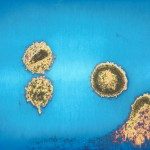Lien vers Pubmed [PMID] – 23080489
Lien DOI – 10.1002/jmv.23409
J Med Virol 2012 Dec; 84(12): 1869-75
The present study describes a follow-up of a prospective and observational cohort of patients infected with HIV-1 and treated with raltegravir for salvage therapy in Brazil. Two groups of patients were analyzed: switching from T20 to RAL (Group 1, n = 9) and salvage therapy containing RAL (Group 2, n = 10). Blood samples were drawn for CD4(+) T-cell counts and HIV-1 viral load determinations. Protease, reverse transcriptase, and integrase genotyping were performed at baseline and at the time of virologic failure. CD4(+) T-cells increased at 6 and 12 months in both groups; HIV-1 viral load was continuously suppressed for Group 1, and for Group 2 it significantly decreased after starting a RAL-containing regimen. Three out of 10 patients from Group 2 could not suppress HIV-1 viral load. The mutations Q148H + G140S were observed for two patients and for the third patient only mutations to PR/RT inhibitors were detected. The genotypic sensitivity score (GSS) was analyzed for all patients of Group 2 and both patients who developed resistance to raltegravir presented a GSS < 2.0 for the RAL-containing scheme, which could be associated to the lack of effectiveness of the proposed scheme. The present study describes, for the first time in Brazil, the close follow-up of a series of patients using a raltegravir-containing HAART, showing the safety of the enfuvirtide switch to RAL and the effectiveness of a therapeutic regimen with RAL in promoting immune reconstitution and suppressing HIV replication, as well as documenting the occurrence of resistance to integrase inhibitors in the country.


